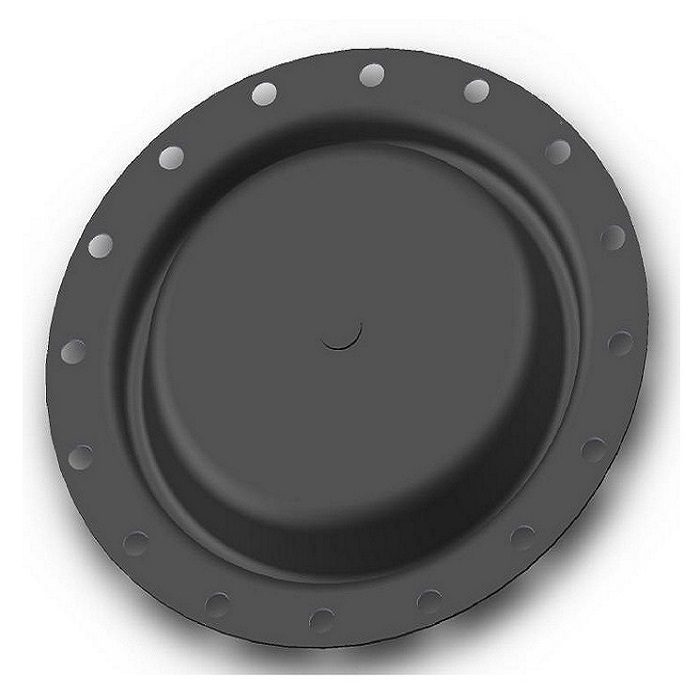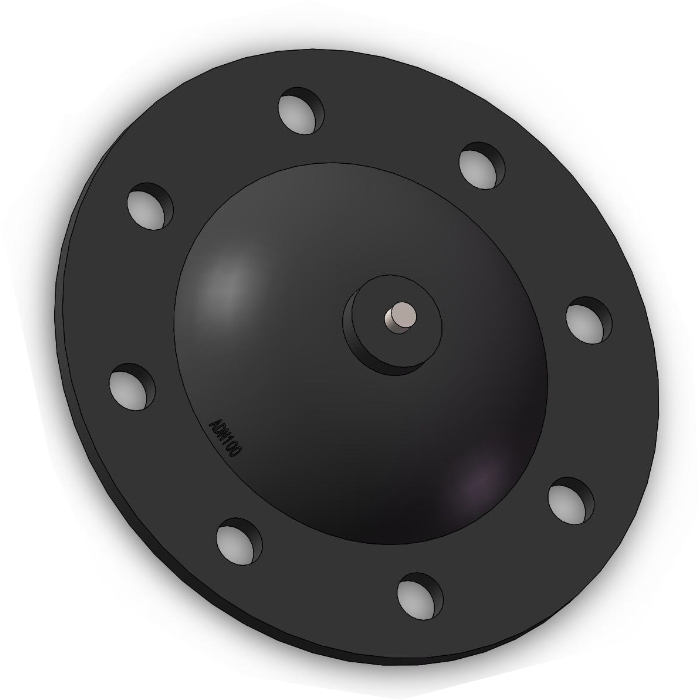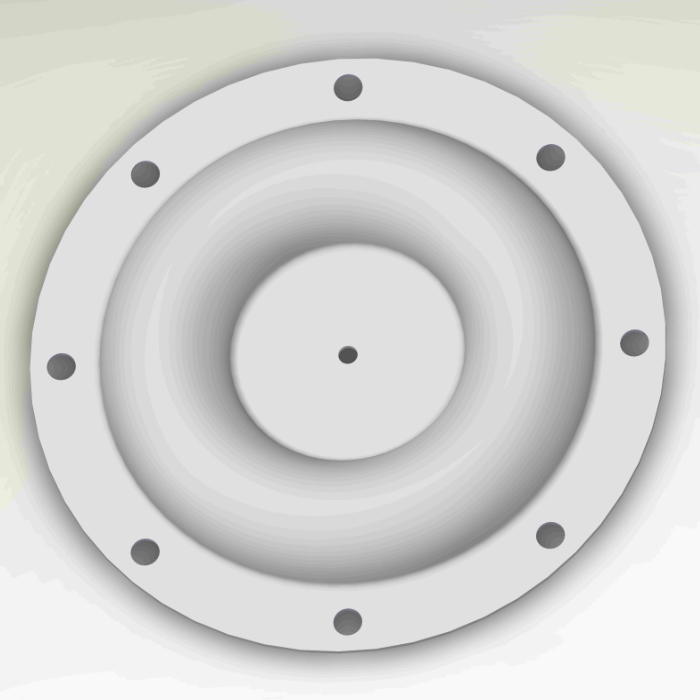GENERAL SEALTECH LIMITED is a high-quality diaphragm product manufacturer that provides comprehensive services and has been meeting the diverse needs of many customers for over 20 years. We produce high-quality diaphragm products to meet your batch and customization needs. Our tradition is to maintain the shortest turnaround time in the industry, making us your reliable diaphragm production partner. Our engineers check the specified quality through tolerances on dimensions and required performance of the finished product to ensure timely delivery. Provide high-quality products at competitive prices and deliver them on time.
Rubber diaphragms is a material and technology that helps to achieve specific functions or protocols. It is usually used to control the flow of matter and maintain stable states between various fluids in the system.

Rubber diaphragms is a universal and flexible sealing component that can provide variable sealing in flow control applications. The rubber diaphragms produced by GENERAL SEALTECH LIMITED are made of various single and composite elastomers, suitable for various industry applications.
The diaphragm is considered the most valuable component to meet all sealing needs, and our diaphragm seals are produced to adapt to any challenging shape and configuration, depending on your application requirements.
molded rubber diaphragms is a flexible diaphragm, sometimes reinforced with fabric, strategically placed to prevent unnecessary transfer of material between two places by forming a seal. They can be used to separate two gases, two liquids, or one gas and one liquid that should not be mixed.
In fact, diaphragms come in various shapes and sizes. The thickness depends on the diameter and flexibility of the diaphragm
Membranes can be made of various materials, depending on the final application. Diaphragms have a wide range of applications, but are most commonly used in environments with pressure differences. The diaphragm has low fluid permeability and the ability to bend left and right, making it a sealing solution while providing consistent pressure difference.

Why choose us?
- 11. We have more than 15 years of industry experience in water treatment.2. High quality products and competitive price.
3. We have professional business personnel and engineers to provide you with type selection assistance and technical support.
molded rubber diaphragms–A Guide to Frequently Asked Questions
2.How are diaphragms designed to resist abrasion and wear in applications with abrasive media?
3.What types of sealing mechanisms are commonly used with diaphragms, such as clamped, bolted, or adhesive seals?
4.How do molded rubber diaphragms respond to cyclic or pulsating pressure loads, and what is their fatigue life in such conditions?
5.Are molded rubber diaphragms used in safety relief valves and pressure relief devices to prevent overpressure situations?
6.Are there diaphragms designed for quick and easy replacement to minimize downtime in industrial processes?
7.Are there diaphragms equipped with built-in sensors for real-time monitoring and feedback in automated systems?
8.What is the role of diaphragms in controlling the flow of aggressive or corrosive chemicals in chemical processing applications?
9.Are diaphragms suitable for use in applications involving harsh radiation or extreme pressure differentials?
10.How do molded rubber diaphragms contribute to the isolation of different process media or gases within a system?
11.What are the common materials used in diaphragm manufacturing, and how do they impact the diaphragm’s performance?
12.How do diaphragms provide sealing solutions in hydraulic accumulators and fluid reservoirs?
1.What is a diaphragm?
A diaphragm is a thin, dome-shaped muscle located between the thoracic and abdominal cavities. It is the primary muscle of respiration and helps to regulate the flow of air into and out of the lungs. The diaphragm also plays an important role in aiding digestion by helping to move food through the digestive tract.
2.How are diaphragms designed to resist abrasion and wear in applications with abrasive media?
Diaphragms are designed to resist abrasion and wear in applications with abrasive media by using materials that are highly resistant to abrasion and wear. These materials include polyurethane, rubber, and other elastomers. The diaphragm is also designed with a thicker wall and reinforced edges to provide additional protection against abrasion and wear. Additionally, the diaphragm may be coated with a protective material such as a fluoropolymer to further reduce wear and tear.
3.What types of sealing mechanisms are commonly used with diaphragms, such as clamped, bolted, or adhesive seals?
1. Clamped Seals: Clamped seals are the most common type of diaphragm seal. They are typically used in applications where the pressure is relatively low and the temperature is not too extreme. Clamped seals are easy to install and provide a reliable seal.
2. Bolted Seals: Bolted seals are used in applications where the pressure is higher and the temperature is more extreme. They are more difficult to install than clamped seals, but provide a more reliable seal.
3. Adhesive Seals: Adhesive seals are used in applications where the pressure is low and the temperature is not too extreme. They are easy to install and provide a reliable seal. However, they are not as reliable as clamped or bolted seals.
4.How do molded rubber diaphragms respond to cyclic or pulsating pressure loads, and what is their fatigue life in such conditions?
molded rubber diaphragms respond to cyclic or pulsating pressure loads by flexing and deflecting in response to the pressure. The fatigue life of a diaphragm in such conditions depends on the material used, the frequency of the pressure load, and the magnitude of the pressure load. Generally, fatigue life is shorter for higher frequency and higher magnitude pressure loads.

5.Are molded rubber diaphragms used in safety relief valves and pressure relief devices to prevent overpressure situations?
Yes, molded rubber diaphragms are commonly used in safety relief valves and pressure relief devices to prevent overpressure situations. The diaphragm is a flexible membrane that is designed to open when the pressure inside the device reaches a certain level, allowing the pressure to be released.
6.Are there diaphragms designed for quick and easy replacement to minimize downtime in industrial processes?
Yes, there are diaphragms designed for quick and easy replacement to minimize downtime in industrial processes. These diaphragms are typically made of materials such as rubber, silicone, or PTFE, and are designed to be easily replaced without the need for tools or special equipment. Additionally, some diaphragms are designed with quick-connect fittings to further reduce downtime.
7.Are there diaphragms equipped with built-in sensors for real-time monitoring and feedback in automated systems?
Yes, there are diaphragms equipped with built-in sensors for real-time monitoring and feedback in automated systems. These diaphragms are typically used in industrial applications such as pumps, valves, and compressors. The sensors measure the pressure and flow of the system and provide feedback to the control system to ensure the system is operating correctly.
8.What is the role of diaphragms in controlling the flow of aggressive or corrosive chemicals in chemical processing applications?
Diaphragms are used to control the flow of aggressive or corrosive chemicals in chemical processing applications. They act as a barrier between the chemical and the process equipment, preventing the chemical from coming into contact with the equipment and causing corrosion or other damage. Diaphragms are also used to regulate the flow of the chemical, allowing for precise control of the process.

9.Are diaphragms suitable for use in applications involving harsh radiation or extreme pressure differentials?
No, diaphragms are not suitable for use in applications involving harsh radiation or extreme pressure differentials. Diaphragms are designed to be used in applications with relatively low pressure differentials and are not designed to withstand extreme temperatures or radiation.
10.How do molded rubber diaphragms contribute to the isolation of different process media or gases within a system?
molded rubber diaphragms are used to separate different process media or gases within a system by creating a physical barrier between them. This barrier prevents the media or gases from mixing, thus providing a degree of isolation. Diaphragms are also used to control the flow of media or gases within a system, as they can be designed to open and close in response to pressure or other external factors.
11.What are the common materials used in diaphragm manufacturing, and how do they impact the diaphragm’s performance?
Common materials used in diaphragm manufacturing include rubber, silicone, neoprene, polyurethane, and polyester. Each material has its own unique properties that can affect the performance of the diaphragm.
Rubber is a popular choice for diaphragms due to its flexibility and durability. It is also resistant to heat, chemicals, and abrasion. However, rubber can be prone to cracking and tearing over time.
Silicone is a synthetic material that is highly resistant to heat and chemicals. It is also very flexible and can be used in a wide range of applications. However, silicone can be prone to tearing and is not as durable as rubber.
Neoprene is a synthetic rubber material that is highly resistant to heat, chemicals, and abrasion. It is also very flexible and can be used in a wide range of applications. However, neoprene can be prone to cracking and tearing over time.
Polyurethane is a synthetic material that is highly resistant to heat, chemicals, and abrasion. It is also very flexible and can be used in a wide range of applications. However, polyurethane can be prone to cracking and tearing over time.
Polyester is a synthetic material that is highly resistant to heat, chemicals, and abrasion. It is also very flexible and can be used in a wide range of applications. However, polyester can be prone to cracking and tearing over time.
12.How do diaphragms provide sealing solutions in hydraulic accumulators and fluid reservoirs?
Diaphragms provide sealing solutions in hydraulic accumulators and fluid reservoirs by creating a barrier between the fluid and the atmosphere. This barrier prevents the fluid from leaking out and keeps the pressure inside the accumulator or reservoir at a constant level. The diaphragm also helps to reduce the amount of air that can enter the system, which helps to reduce the risk of cavitation.


